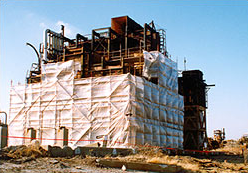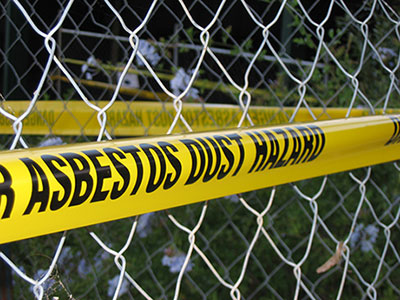Asbestos Abatement
Watch the process
As a licensed and responsible professional you must be aware of and identify the presence or absence of these materials when dealing with building retrofits. Failure to advise your client(s) or contractors working on a project of the presence of hazardous materials in and/or on a property may present you with potential future liabilities. It is your obligation to protect the interests of your client(s), the health and safety of workers, and the natural environment.

National Environmental Contracting will arrange an independent consultant for hazardous materials and other potential environmental concerns on residential, commercial and industrial properties. Each assessment includes sampling of all suspected hazardous materials, confirmatory laboratory analysis and complete reporting of all findings. We can also complete specifications and tender packages for any required remedial activities and perform project management services.
All environmental consultants and environmental engineers are licensed, have errors and omissions insurance and pollution, asbestos and environmental coverage.

What to Do if You Have It
North America has become asbestos conscious. With so many buildings and facilities containing asbestos, the prudent building manager must implement an Asbestos Management and Maintenance Program.
Beginning in the 1920's and continuing into the mid 1970's asbestos insulation and building material were widely used in the construction industry due to its low cost, strength and ability to withstand high temperatures. In Canada, there are thousands of miles of asbestos pipe covered materials. However, it is not always economically feasible or desirable to carry out removal procedures.
The Asbestos Management and Maintenance Program
STEP ONE: Assessment and Survey
The first step of the Asbestos Management Program is to do an asbestos survey to assess the location, identify the type of asbestos, the condition of the asbestos and identify a maintenance record. This asbestos inventory or assessment is usually carried out by an independent consulting firm. This assessment or survey will include:
- Identification and location of the Asbestos Containing Materials (ACM)
- Assessing the condition of asbestos and its accessibility.
- Preparing a long term plan to outline the corrective action(s) to be taken and the immediate and long-term costs associated with the corrective action(s).
STEP TWO: Notification
Once the assessment or survey is completed, this will allow the building manager to implement the second step of the program, which includes notifying tenants, custodial and maintenance staff, building maintenance and service contractors. This notification includes identifying the location of the asbestos containing materials.
STEP THREE: Worker Training
A Health and Safety Training Program should be established including an inspection policy and employee training program. Employees who are most likely to come into contact or work with asbestos should be included. Good communication is vital. All sub trades and maintenance contractors should be notified.
STEP FOUR: Corrective Measures - Correction and Remedial Action
Where the survey or assessment has identified Asbestos Containing Materials (ACM) which are severely damaged or deteriorated, the building manager then decides which of the following three methods of corrective or remedial measures are going to be used.
1. Removal By Type 1, Type 2, or Type 3 Operational Procedures As a rule, removal will initially be the most expensive method. However, depending on the circumstances, in the long run, asbestos removal can be an economically preferred option. Removal of asbestos is the only permanent solution.
In most cases, where Asbestos Containing Materials (ACM) are removed, an appropriate substitute material must be reinstalled. Fibreglass pipe covering is a widely used product and the costs associated with supplying and installing this new material are relatively low.
In Type 3 Operational Procedures, an eight chamber Decontamination Structure is installed. A Dirty Area Room, Garbage Storage Area and Clean Area & Room with airlocks are temporarily installed. These Decon's have filtered showering facilities. The water is filtered through a .05 micron filter collected into 45-55 gallon drums for testing prior to any discharge.
Under Type 3, the area is kept constantly under negative pressure. HEPA Filtered Negative Air Pressure Units are installed strategically and vented outside. All electrical equipment, HEPA Vacuums, temporary lighting and Negative HEPA Air Units are hooked up to temporary Ground Fault Interrupt (GFI) panels. The area will have electrical lockouts where required.
2. Encapsulation Encapsulation is a successful option in dealing with asbestos and involves covering the asbestos with a sealant.
Asbestos Containing Materials (ACM), all piping, elbows, boilers and all mechanical insulation covered with ACM and asbestos are HEPA vacuumed and covered with a canvas fire-rated adhesive sealant (encapsulation). Depending on the application, there are a number of types of sealant.
The sealant's function is to enclose and prevent the asbestos fibres from breaking away from the material. In the case of asbestos pipe insulation, elbows or trees, a canvas with a fire retardant lockdown adhesive lagging is applied to cover and provide a hard-shell coating.
Encapsulation requires periodic inspections, quarterly or annually, to monitor the condition of the Asbestos Containing Materials.
2. Enclosure The Enclosure method permanently closes the asbestos. The enclosure must be completely airtight and this method is best used only where access to electrical, plumbing or ventilation services are not required.
STEP FIVE: Hiring an Asbestos Control Contractor
The Asbestos Control Contractor should be experienced in all of the three methods mentioned above: Removal, Encapsulation and Enclosure and Insulation procedures.
References must be checked thoroughly to determine the quality of services:
- was the client satisfied with the contractor's performance?
- was the contractor's staff knowledgeable and fully trained?
- did they complete the job on time?
- what is the availability and schedule performance?
PROTECT YOUR PERSONAL AND CORPORATE ASSETS
For Asbestos Containing Materials (ACM) that require immediate attention, a qualified Asbestos Control Contractor can be retained on the following terms:
- GUARANTEED PRICE CONTRACT - to complete the initial removal or encapsulation work required by the consultant's recommendations, for a fixed lump sum price.
- SERVICE CONTRACT - on standing offer and on a time and material basis. The contractor must be available to service your asbestos, just as your mechanical contractor services you air conditioning. Every building manager should have an Asbestos Service Contractor in case of an emergency.
One requirement of the regulation governing asbestos on construction sites is the classification of the work. This classification can be thought of in terms of work representing a high (Type 3) or medium (Type 2) or low hazard (Type 1). In evaluating the hazard, there are two necessary considerations:
- the airborne concentrations of asbestos that will be generated by the work
- the duration of the exposure
Level of Airborne Asbestos

Factors that effect the level of airborne asbestos include the following:
- the nature of the asbestos materials
- how the work is performed - Quality and Health and Safety Training
- the availability of controls to limit exposure
Conclusion
The key factors are in a successful Asbestos Management and Maintenance Program are management, communication and control. You and your company must implement an asbestos management control program and define the company's asbestos policy in a long term plan.
The long term plan allows you to be in control of the asbestos and be ready to respond quickly and decisively and to avoid costly emergency crisis situation.